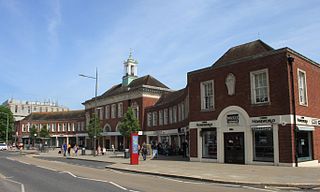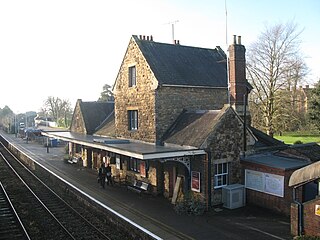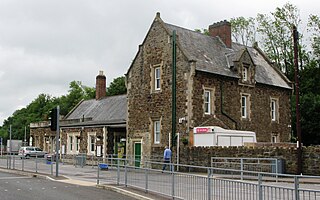
Yeovil Junction railway station is the busier, but less central, of two railway stations serving the town of Yeovil in England. The station is 2 miles (3.2 km) outside the town, in the village of Stoford. Although Yeovil is in Somerset, the station was in Dorset until 1991. It is 122 miles 48 chains (197.3 km) down the line from London Waterloo.

The West of England line is a British railway line from Basingstoke, Hampshire, to Exeter St Davids in Devon, England. Passenger services run between London Waterloo station and Exeter; the line intersects with the Wessex Main Line at Salisbury. Despite its historic title, it is not today's principal route from London to the West of England: Exeter and everywhere further west are reached more quickly from London Paddington via the Reading–Taunton line.

The Tarka Line, also known as the North Devon Line, is a local railway line in Devon, England, linking the city of Exeter with the town of Barnstaple via a number of local villages, operated by Great Western Railway (GWR). The line opened in 1851 from Exeter to Crediton and in 1854 the line was completed through to Barnstaple. The line was taken over by the London and South Western Railway (LSWR) in 1865 and later became part of the Southern Railway and then British Rail. In 2001, following privatisation, Wessex Trains introduced the name Tarka Line after the eponymous character in Henry Williamson's book Tarka the Otter. The line was transferred to First Great Western in 2006.

Exeter St Davids is the principal railway station serving the city of Exeter in Devon, England. It is 193 miles 72 chains from the zero point at London Paddington on the line through Bristol which continues to Plymouth and Penzance. It is also served by an alternative route to London Waterloo via Salisbury and branch lines to Exmouth, Barnstaple, and Okehampton. It is currently managed by Great Western Railway and is served by trains operated by Great Western Railway, South Western Railway and CrossCountry.

Exeter Central railway station is the most central of the stations in the city of Exeter, Devon, United Kingdom. It is 171 miles 30 chains (275.8 km) down the line from London Waterloo. The station is smaller than Exeter St Davids on the west side of the city. Great Western Railway manages the station and operates most services, with South Western Railway providing the rest.

Topsham railway station is the railway station serving the town of Topsham in the English county of Devon. It is the passing place for the otherwise single-track branch line from Exmouth Junction to Exmouth. Both the loop and adjacent level crossing are remotely worked from the signal box at Exmouth Junction.

Woking railway station is a major stop in Woking, England, on the South West Main Line used by many commuters. It is 24 miles 27 chains (39.2 km) down the line from London Waterloo. The station is managed by South Western Railway, who operate all trains serving it.

Feniton railway station serves the village of Feniton in Devon, England. It was opened by the London and South Western Railway (LSWR) in 1860 but is now operated by South Western Railway which provides services on the West of England Main Line. It is 159 miles 24 chains (256.4 km) down the line from London Waterloo.

Honiton railway station serves the town of Honiton in east Devon, England. It is operated by South Western Railway and is 154 miles 60 chains (249.0 km) down the line from London Waterloo, on the West of England Line.

Axminster railway station serves the town of Axminster in Devon, England. It is operated by South Western Railway and is situated on the West of England Main Line. It is 144 miles 41 chains (232.6 km) down the line from London Waterloo.

Sherborne railway station serves the town of Sherborne in Dorset, England. It is situated on the West of England Main Line, 118 miles 4 chains (190.0 km) down the line from London Waterloo and is currently operated by South Western Railway.

Templecombe railway station serves the town of Templecombe in Somerset, England. It is situated on the West of England Main Line, 112 miles 2 chains (180.3 km) down the line from London Waterloo. The main station opened in 1860 but a smaller station on the lower line opened in 1862. It was closed in 1966 but was reopened in 1983 following local community pressure. It is currently operated by South Western Railway.

Salisbury railway station serves the city of Salisbury in Wiltshire, England. It is 83 miles 43 chains (134.4 km) from London Waterloo on the West of England line to Exeter St Davids. This is crossed by the Wessex Main Line from Bristol Temple Meads to Southampton Central. The station is operated and served by South Western Railway (SWR), and is also served by Great Western Railway (GWR).

Crediton railway station is a railway station serving the town of Crediton in Devon, England. It is 7 miles 76 chains (12.8 km) from Exeter Central at milepost 179.25 from London Waterloo.

Barnstaple railway station is the northern terminus of the Tarka Line and serves the town of Barnstaple, Devon. It is 39 miles 75 chains (64.3 km) from Exeter Central and 211.25 miles (339.97 km) from London Waterloo. It is managed by Great Western Railway, which also operates the passenger service.

Exmouth Junction is the railway junction where the Exmouth branch line diverges from the London Waterloo to Exeter main line in Exeter, Devon, England. It was for many years the location for one of the largest engine sheds in the former London and South Western Railway. The sidings served the railway's concrete casting factory as well as a goods yard.

The Devon and Somerset Railway (D&SR) was a cross-country line that connected Barnstaple in Devon, England, to the network of the Bristol and Exeter Railway (B&ER) near Taunton. It was opened in stages between 1871 and 1873 and closed in 1966. It served a mostly rural area although it carried some through services from east of Taunton to the seaside resort of Ilfracombe.

The Exeter to Plymouth railway of the London and South Western Railway (LSWR) was the westernmost part of a route competing with that of the Great Western Railway (GWR) and its 'associated companies' from London and Exeter to Plymouth in Devon, England. Whereas the GWR route from Exeter followed the coast to Newton Abbot and then went around the southern edge of Dartmoor, the LSWR route followed the northern and western margins of Dartmoor, passing through the towns of Crediton, Okehampton, and Tavistock.
This article describes the history and operation of the railway routes west of Salisbury built by the London and South Western Railway (LSWR) and allied companies, which ultimately became part of the Southern Railway in the United Kingdom. Salisbury forms a natural boundary between the Southern Railway core routes in the counties surrounding London, and the long route connecting with the Devon and Cornwall lines.

Chard Junction railway station was situated on the London and South Western Railway’s West of England Main Line about 1 mile (1.6 km) southeast of the village of Tatworth in Somerset, England. It was the junction of a short branch line to Chard. It was opened in 1860 as Chard Road, and closed in 1966. An adjacent milk depot was served by its own sidings from 1937 to 1980. Chard Junction signal box remained open to control Station Road level crossing and a passing loop on the long section of single track railway between Yeovil Junction and Pinhoe until March 2021, when control was passed to Basingstoke.




















